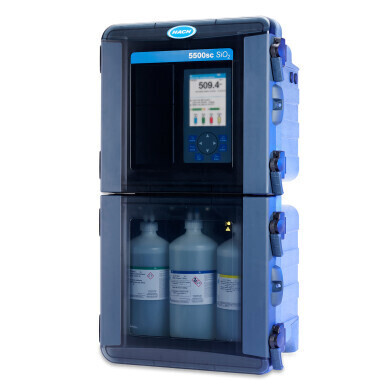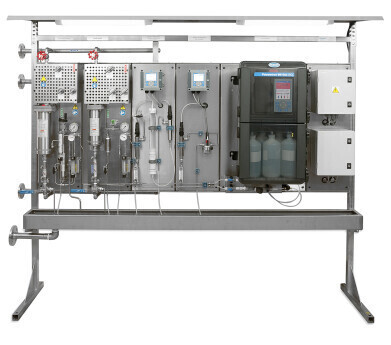Water/wastewater
Monitoring silica in the water/steam cycle
Jul 09 2024
Silica (silicon dioxide) is highly soluble in steam, so if sufficient quantities are present, it may deposit as a glass-like substance on the surfaces of boiler tubes and turbine blades at power plants, with serious consequences such as reduced thermal efficiency and even plant failure…
Silica (SiO2) is found in most natural waters, either dissolved or in the form of suspended silicate particles. Silica compounds are also widely used in industrial applications, including food and pharmaceutical production, as additives and for water filtration.
Among the many contaminants in the steam/water circuit, silica plays a special role because of its high solubility in steam. When steam cools down, acid-resistant silica deposits can occur on boiler tubes and heat exchangers, which can impair the thermal efficiency of industrial systems. For example, a deposit of just 0.1 mm can reduce thermal transfer by 5 %, which harms the efficiency of the entire plant.
Silica deposition on turbine blades can cause pitting and other defects, resulting in costly downtime. However, defects are also likely to cause an imbalance in the blades, which in turn causes vibration and could even result in failure due to the fine tolerances between turbine blades and outer casings.
Years of experience have enabled the specification of tolerable concentrations of SiO2 in steam to avoid turbine damage. At an operating pressure of 180 bar, boiler water should not contain more than 100 ppb of SiO2 in order to achieve a maximum of 5 ppb of SiO2 in the steam, assuming ideal boiler conditions are met. Once-through boilers require SiO2 concentration to be lower than drum boilers, since all water (and the impurities it contains) is converted into vapour and there is no possibility for blow-down.
Silica measuring points in the water/steam cycle
- During demineralisation: Both the efficiency of the exchanger resins and the depletion of the absorption capacity (breakthrough) can be monitored with high sensitivity and reliability by determining the silicic acid. The regeneration cycles can thus be optimised.
- In boiler feed water: Guidelines from the international technical VGB association stipulate one normal and two alarm levels for the silica concentration. Various countermeasures are recommended depending on the level at which the concentration is exceeded.
- Boiler blowdown: The goal of the blowdown process is to drain contaminated water from the steam boiler, which also removes a number of impurities such as precipitated sludge and dissolved solids. Continuous monitoring of control parameters such as silica is required to appropriately control blowdown in order to assess the effectiveness of the water chemistry in the steam boiler. This also avoids high fluctuations in the boiler chemistry.
Silica concentration data is required to demonstrate compliance with the required levels for boiler feedwater and saturated steam. However, the data is also necessary for operational purposes; to control pH in the boilers with ammonia dosing for example. In addition, the data is required for insurance purposes.
Silica monitoring solutions
Silica can be measured as a grab sample in the laboratory with a spectrophotometer system like the DR3900 and ready-to-use reagents. However, for continuous protection, for the rapid detection of changes in silica levels and to be able to monitor trends, the Hach® 5500sc Silica analyser is highly beneficial:
- 90 days of continuous runtime: Only two litres of each reagent are required for the analyser to perform unattended for up to 3 months.
- Save time on maintenance: High reliability – pressurised reagent delivery system with no pumps or wearing parts
- Avoid downtime: Predictive diagnostic tools, including Hach’s proprietary Prognosys technology, warning LEDs, and high-visibility notification screens
- Clean, fast and easy reagent change: Re-designed reagent bottles and improved connection to the analyser saves time and gets rid of dripping reagents. Hach ready-to-use reagents are formulated for optimal accuracy and designed with convenient features like color-coded caps and sealed bottles allowing quick and clean reagent replacement.
- Verify easily with Hach lab products: Grab Sample In and Out features allow quick analysis of a grab sample poured into the analyser and facilitate the simple removal of a sample from the analyser for verificationin the laboratory.
Digital Edition
AET 29.2 May 2025
May 2025
Water / Wastewater- From Effluent to Excellence: Microbiological assessment of a containerized modular water reuse pilot system- Without water everything comes to a haltAir Monitoring- Probe Sampli...
View all digital editions
Events
Jun 17 2025 Guangzhou, China
Singapore International Water Week Spotlight 2025
Jun 23 2025 Singapore
Jun 24 2025 Santa Clara, CA, USA
Jun 25 2025 Sao Paulo, Brasil
Jun 28 2025 Albena, Bulgaria






_1000x1500.jpg)


.jpg)

.jpg)












